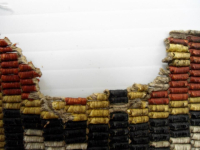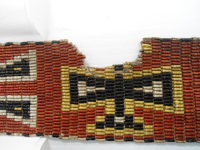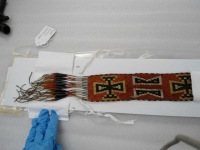quilled sash
quilled sash
quilled sash
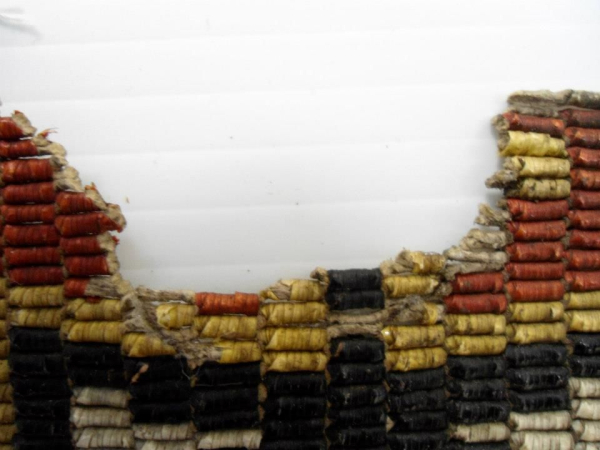
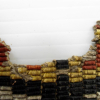
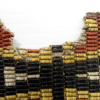
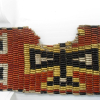
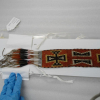
This relative is a Haudenosaunee sash, decorated with porcupine quills, ohaˀdaˀ, and believed to have been worn on hunting expeditions. It is dated to 1700. It is believed the sash afforded protection or brought good luck in hunting. Two sets of unique hour-glass or cross motifs are woven along the length of the sash. The motifs are arranged in an alternating pattern: a single hourglass or cross followed by a pair of hour-glasses or crosses. The ancestor is constructed using a netted or net-work technique, and is made with tanned hide thongs, porcupine quills, metal cones, hair, and dyes in the colours of red-orange, yellow, black, white.
The ancestor is currently housed at the Canadian Museum of History.
This sash was listed as being Haudenosaunee by Arthur Speyer in his notes regarding his collection.
Canadian Museum of History records
Read More About This Relative
The sash is made using tanned hide thongs; porcupine quills; metal cones; hair; dyes, including red-orange, yellow, black, and white.
The porcupine quills and hair were coloured using natural dyes and appear in white, red-orange, yellow and black; the hair is dyed red-orange. The thirty-five thongs that comprise the sash are bound together in groups of two by porcupine quills, using a wrapping technique called net-work. Wrapping consists of twisting flattened quills around each strip. In net-work wrapping, the first row of two hide strips are bound together by a single porcupine quill, the ends of which are secured underneath the first and last turns of the quill. In the next row, the first and last strips are wrapped singly and all the intervening strips are wrapped in pairs. This alternation continues throughout the body of the sash. The fringe at either end of the sash consists of pairs of quill-wrapped thongs. These ends of these strands are capped by metal cones, which were likely hammered out and rolled. Tufts of hair and the ends of the thongs protrude through the cones.
The background of the sash is composed of red-orange quills, while the top and bottom edges consist of two hide strands wrapped in an alternating pattern of black and white. Two motifs alternate along the length of the sash, except in the center where the first motif is repeated to form a pair. The first motif resembles an hourglass, comprised of two white triangles outlined in black. This is crossed horizontally at the center by a black band with two smaller black triangles at each end with white centers; this entire shape is outlined in yellow. The second motif consists of a black hourglass shape, vertically split in half and outlined in white. A small yellow area appears in the center of each black triangle.
It is likely the relative was thought to afford protection or bring good luck in hunting. In his article, “Good Luck in Hunting: James Bay Indian Art” curator Ted Brasser discusses the significance of symbols on clothing. This sash's iconography was likely realized from dream images or visions and executed in the sash as a way to communicate to other spirits that the hunter was under the protection of powerful spirits or to please the animals spirits he hunted. Like Brasser, Ruth Phillips also suggests that symbols on clothing or accessories were likely derived from dreams or visions and thought to bring protection or good fortune to the wearer. This interpretation would be consistent with other elements of the sash that are associated with hunting practices. For example, the edges of the sash are trimmed with porcupine quill-wrapped fringe and hair tassels in conical brass jingles are attached to the ends. Tassels and fringes decorating most objects made of hide or skin were also thought to bring good luck in hunting.
It is likely that this sash was worn by hunters on hunting expeditions. This conclusion is based on a documentary illustration from Library and Archives Canada, in the form of an historical watercolour by James Peachy entitled, A Plan of the Inhabited Part of the Province of Quebec, ca. 1785. In the work, two hunters, as well as a woman and child appear in a canoe. The two men can be identified as hunters by the firearms that they carry. Significantly, the clothing worn by the hunters in the work is shown in great detail. Although sashes were typically belted around the waist or worn diagonally across the shoulder, as is the case with the hunter on the left, smaller sashes could be worn as head bands , similar to the one worn by the hunter on the right. The head-piece worn by the man on the right is possibly a sash. It is likely that the sash in question was worn in any of these ways; this is also consistent with contemporary knowledge of how sashes are worn.
This relative may have been a headband, given its similarity in design to a headband depicted in the 1785 watercolour by artist James Peachey. This watercolour is located in the collection of Library and Archives Canada, titled "Un plan de la partie habitée de la province de Québec," Item ID number: 2898254. (This information was provided by Tom Connin in March 2024 via GRASAC webform submission).
The fringes at either side are both 19 cm long.
Arthur Speyer's notes regarding his collection date this sash to approximately 1700.
Provenance
The collection was first shown publicly in Germany in an exhibition entitled Indianer Nordamerikas 1760 - 1869 American Indian Artifacts of Speyer Collection in 1968. The exhibition produced a catalogue outlining the extensive collection of Indigenous North American artifacts, clothing, and tools, and was published by the Deutschen Ledermuseum, in Offenbach. The Canadian Museum of History then held an exhibition curated by Ted Brasser and Judy Thompson, Bo’jou Neejee, an exhibition of the Speyer Collection held at the CMH in 1976.
Benndor, Helga and Arthur Speyer. Indianer Nordamerikas 1760-1860. Aus der Sammlung Speyer. (Ausstellung. Katalog.) Offenbach a.M., Deutsches Ledermuseum, Deutsches Schuhmuseum, 1968
Brasser, Ted. Bo'jou, Neejee!: profiles of Canadian Indian art. Ottawa: National Museum of Man, 1976.
This data was copied from museum records
The Canadian Museum of History has copies of newspaper articles and coverage of the acquisition of the Speyer collection in their archival holdings.
About This GRASAC Record
Unknown Maker. " Hodenausaunee Porcupine Quill Sash" GRASAC ID 1481. Located in the Canadian Museum of History, catalogue number III-X-233.
Record based on research carried out by a student in ARTH 5210, Fall term 2012, Carleton University, taught by Ruth Phillips with Judy Hall.
This record was augmented by Shamina Vastani in December 2023.
The images presented here provide a closer view of the quill work. Images from the CMH provide a planar (full view of the entire sash) view which is helpful in appreciating the dimensions and patterns.
45.244211204425, -74.3835528615
This sash was listed as being from the Eastern Great Lakes region by Arthur Speyer in his notes regarding his collection. The pin on the map is not a specific location. It reflects the "Eastern" designation, Haudenosaunee affiliation, and the connections to the sashes shown in the illustration from Quebec.
 Knowledge Sharing Platform
Knowledge Sharing Platform

